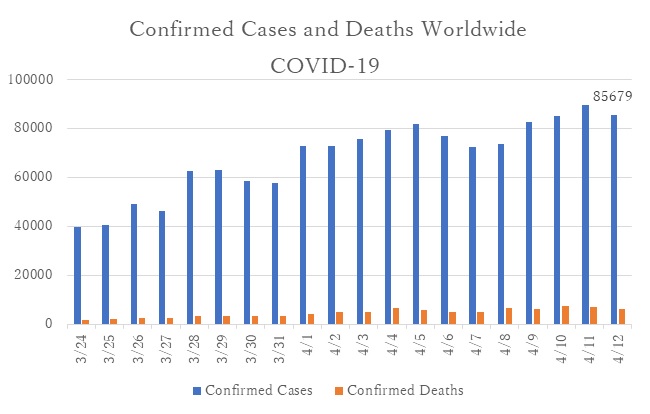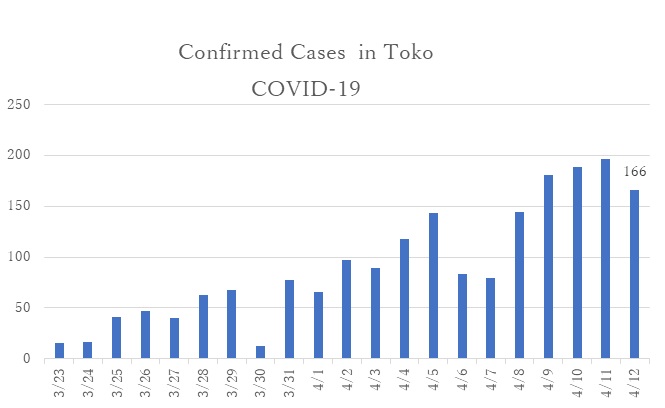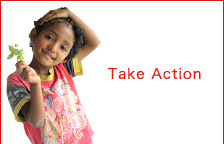SHARE
Services for the Health in Asian & African Regions (SHARE) = SHARE is a citizen sector organization (NGO) that engages in international cooperation mainly through providing health service.
HOME > News > Information of COVID-19(3)
- 【※updated】COVID-19(multi-language)
- Information of COVID-19(15)
- Information of COVID-19(vaccines)
- 《Request to the Government of Japan》Ease the protection of intellectual property rights and promote sharing and cooperating on pharmaceuticals and medical technologies, in order to accelerate efforts to overcome COVID-19 all over the world.
- Information of COVID-19(14)
- Information of COVID-19(13)
- Information of COVID-19(12)
- Information of COVID-19(11)
- SHARE Medical Information Line for Migrants is resumed in Oct.
- Information of COVID-19(10)
Information of COVID-19(3)

Information of COVID-19 (3)by SHARE 2020.04.13
1.Global and Japanese Situation of COVID-19
Confirmed cases of COVID-19 worldwide according to reports by WHO Update 2020/4/12(Japan Standard Time)
Tokyo 2020/04/12 (Japan Standard Time): Tokyo Prefecture Report


2.Measures being implemented by the Japanese Government (Ministry of Health, Labour and Welfare) against the spread of COVID-19
- In cases where new COVID-19 are confirmed, the official policy is to investigate the existence of asymptomatic close contacts [1], isolate them and monitor their health for signs of COVID-19.
- Investigating asymptomatic close contacts among cluster cases, isolate, and monitor.
- Promoting good hygiene practices as means of raising public awareness about the prevention of the spread of COVID-19 using media campaigns.
- Treating the patients with symptoms of COVID-19 at medical facilities, provide intensive care (e.g., mechanical ventilation and extracorporeal membrane oxygenation) for severe patients.
- Patients with mild symptoms are transferred from hospitals to other facilities such as hotels where they are operated by medical staff, and thereby reduce the load on medical staff on the frontline of medical care.
According to the MHLW, the "close contact with infected persons" generally mean as follows:
- Touching an infected person directly, without anti-infective measures
- Meeting an infected person at a distance of around 2 meters (6 feet) or less
https://www.mhlw.go.jp/stf/seisakunitsuite/bunya/kenkou_iryou/dengue_fever_qa_00014.html#Q7
3.What to do at home
It is very important to initiate good hygiene practices at home.Guidelines of washing hands at home are followed:
- After returning home from outside
- After touching things (such as doorknobs) that other people may have touched
- After coughing, sneezing, or blowing your nose
- After taking care of a person with symptoms
- Before cooking and eating
- After handling human or animal excrement
- After using the toilet
- Wear disposable gloves to clean rooms.
- Clean all surfaces that are touched often every day, like doorknobs, light switches, countertops, desk, remote-control, phones, handles, toilets, faucets, and sinks.
- Wash laundry thoroughly, including cushion and sofa cover.
- Open windows for ventilation (5 to 10 minutes, every 1 to 2 hours during daytime)
Use a separate bedroom and bathroom for a person who is sick (if possible) and open a window for ventilation.
- Wash your hands often with soap and water for at least 20 seconds, especially after interacting with the sick person.
- Wear masks (patients and family members) when you contact within 1-2 meters.
- Ensure that the same person takes care of the sick person (if possible). Wear disposal gloves, and masks. Dispose them in separate bags, and wash hands every time after contacts.
- Avoid touching your eyes, nose, and mouth with unwashed hands.
- Do not share plates with other family members. In case it is necessary to share with other family members, soak in disinfectant or boiled water for 10 minutes before washing with detergents.
- Do not share clothes and bed linens as they be contaminated with body fluids (e.g., vomits, diarrhea). Soak in 80℃ water for 10 minutes, wash separately from other family members. The most common household bleach will work[2].
0.1% for cleaning of body fluids (e.g., vomits, diarrhea): two caps of pet bottle (10ml) in 500ml water
0.05% for regular cleaning (e.g., kitchen stainless, doorknobs, toilet, floors): one caps of pet bottle (5ml) in 500ml water
4.Triage of severe patients
- Triage is a term utilized in emergency and disaster. It the process of sorting victims, as of disaster such as earthquake, to determine medical priority in order to increase the number of survivors.
- Explosive outbreaks of COVID-19 will result in an overwhelming the capacity of medical facilities to handle infected people not only in terms of medical equipment but also human resources. Triage to sort severe and mild cases might be necessary. For example, a patient who is likely to survive and live is more likely to be supported by ventilators and other life-saving equipment. In contrast, others who are unlikely to respond to treatments would not be supported. There have been reports of such cases in other countries. Our organization hopes that this does not arise in Japan.
Reference:
1.https://www.mhlw.go.jp/content/10900000/000620733.pdf
2.https://www.cdc.gov/coronavirus/2019-ncov/if-you-are-sick/index.html
3.http://www.tohoku-icnet.ac/Control/activity/images/guide/post_200316.pdf
4.https://www.nytimes.com/2020/03/21/us/coronavirus-medical-rationing.html
Written by Nakasa T, MD, Co-President of SHARE
Koto K, RN, SHARE advisor
Koto K, RN, SHARE advisor
■English Information
-
Information of COVID-19(1)(ENGLISH)
-
Information of COVID-19(2)(ENGLISH)
-
Information of COVID-19(3)(ENGLISH)
-
Information of COVID-19(4)(ENGLISH)
-
Information of COVID-19(5)(ENGLISH)
-
Information of COVID-19(6)(ENGLISH)
-
Information of COVID-19(7)(ENGLISH)
-
Information of COVID-19(8)(ENGLISH)
-
Information of COVID-19(9)(ENGLISH)
■Useful URLs by multi-languages




